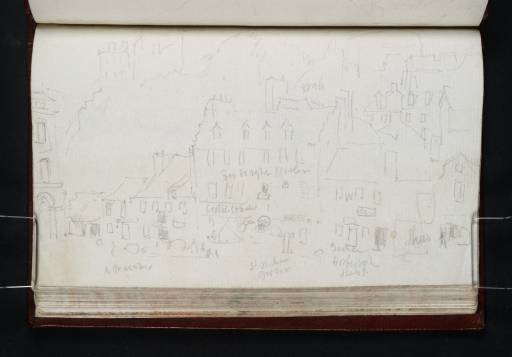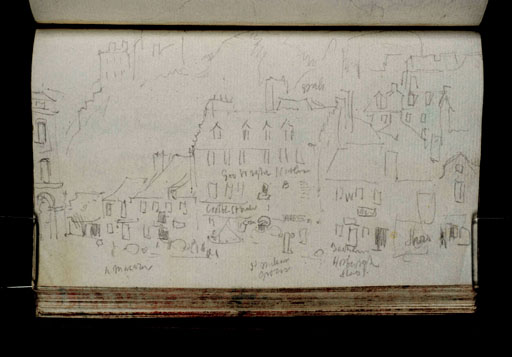Joseph Mallord William Turner The Grassmarket and Edinburgh Castle 1818
Image 1 of 2
Joseph Mallord William Turner,
The Grassmarket and Edinburgh Castle
1818
Joseph Mallord William Turner 1775–1851
Folio 49 Verso:
The Grassmarket and Edinburgh Castle 1818
D13410
Turner Bequest CLXV 49a
Turner Bequest CLXV 49a
Pencil on white laid paper, 99 x 159 mm
Inscribed in pencil by Turner [?] ‘grass’ centre top | ‘G[e]o[rge] Wright [?]Luther’ | Crosby Studio [or stables?]’ centre | ‘N Macarlow’ ?‘ Maker | Grocer’ ?‘Durham | Horburgh | Shop’ bottom, and ‘JMW’ bottom right.
Inscribed in pencil by Turner [?] ‘grass’ centre top | ‘G[e]o[rge] Wright [?]Luther’ | Crosby Studio [or stables?]’ centre | ‘N Macarlow’ ?‘ Maker | Grocer’ ?‘Durham | Horburgh | Shop’ bottom, and ‘JMW’ bottom right.
Accepted by the nation as part of the Turner Bequest 1856
References
1909
A.J. Finberg, A Complete Inventory of the Drawings of the Turner Bequest, London 1909, vol.I, p.480, CLXV 49a, as ‘The Grass market and Castle.’.
The Castle from the Grassmarket was engraved by Henry Le Keux from A.W. Calcott’s design for the fourth number of Scott’s Provincial Antiquities. This page shows Turner’s version of the scene, which concentrates more on the area’s commercial activity than it does on its proximity to the castle or history as the site where condemned criminals were hanged. We look at a row of shops and businesses on the north side of the Grassmarket with the Castle Rock behind.
Turner has fastidiously inscribed the buildings with the names of their proprietors, although, unfortunately his illegible handwriting makes it difficult to be certain of the names, none of which seems to match the famous establishments of the Grassmarket; although ‘B’ may stand for ‘Black Bull’, a tavern that still exists and resembles the building in the centre of this drawing. Turner also inscribed names on sketches of Edinburgh High Street and the West Bow with Heriot’s Hospital on folio 52 verso (D13412; CLXV 50a) and in the Scotch Antiquities sketchbook (Tate D13412, D13697, D13701–D13702, D13708; Turner Bequest CLXVII 65a, 67a, 68, 69); many of these can be made out by the clearer lettering in Turner’s watercolour versions of the subjects: Edinburgh High Street, circa 1818 (Yale Center for British Art)1 and Heriot’s Hospital, circa 1819 (National Gallery of Scotland).2
The inscription at the top of the page, ‘grass’, is easy to make out. The name written across the building in the centre of the picture may be ‘G[e]o[rge] Wright [?]Luther’ (or Heather), with ‘Crosbi studios’ or ‘stables’ written below it. The name at the bottom left may read ‘N Macarlow’. The inscription at the bottom centre of the page may describe two businesses: ‘[...] Maker’ and ‘Grocer’. The inscription at the bottom right looks like: ‘Durham | Horburgh | Shop’. Finally Turner seems to have added his own initials at the very right of the sketch, ‘JMW’. The letters ‘B’ and ‘W’ are also written on two of the buildings, either referring to the proprietors (such as ‘Black Bull’), or perhaps to the appearance of the buildings themselves, for example, ‘black’ and ‘white’, or ‘brick’ and ‘wooden’.
Although the sketch is mainly restricted to architectural outlines, he has included reminders of what the buildings are for such as a shop sign hanging from the building in the centre, and rectangular signs on the other buildings, as well as a series of lines and semicircles on the street outside one of the shops, which may represent barrels or crates waiting to be brought in. He has also captured the distinctive aspects of the architecture in this area of Edinburgh: the tall, narrow tenements with clerestory windows in the roof and crow-step gabling.
At the top of this page, the drawing runs onto the page above (folio 50; D13448; CLXV 50).
Thomas Ardill
November 2007
How to cite
Thomas Ardill, ‘The Grassmarket and Edinburgh Castle 1818 by Joseph Mallord William Turner’, catalogue entry, November 2007, in David Blayney Brown (ed.), J.M.W. Turner: Sketchbooks, Drawings and Watercolours, Tate Research Publication, December 2012, https://www


